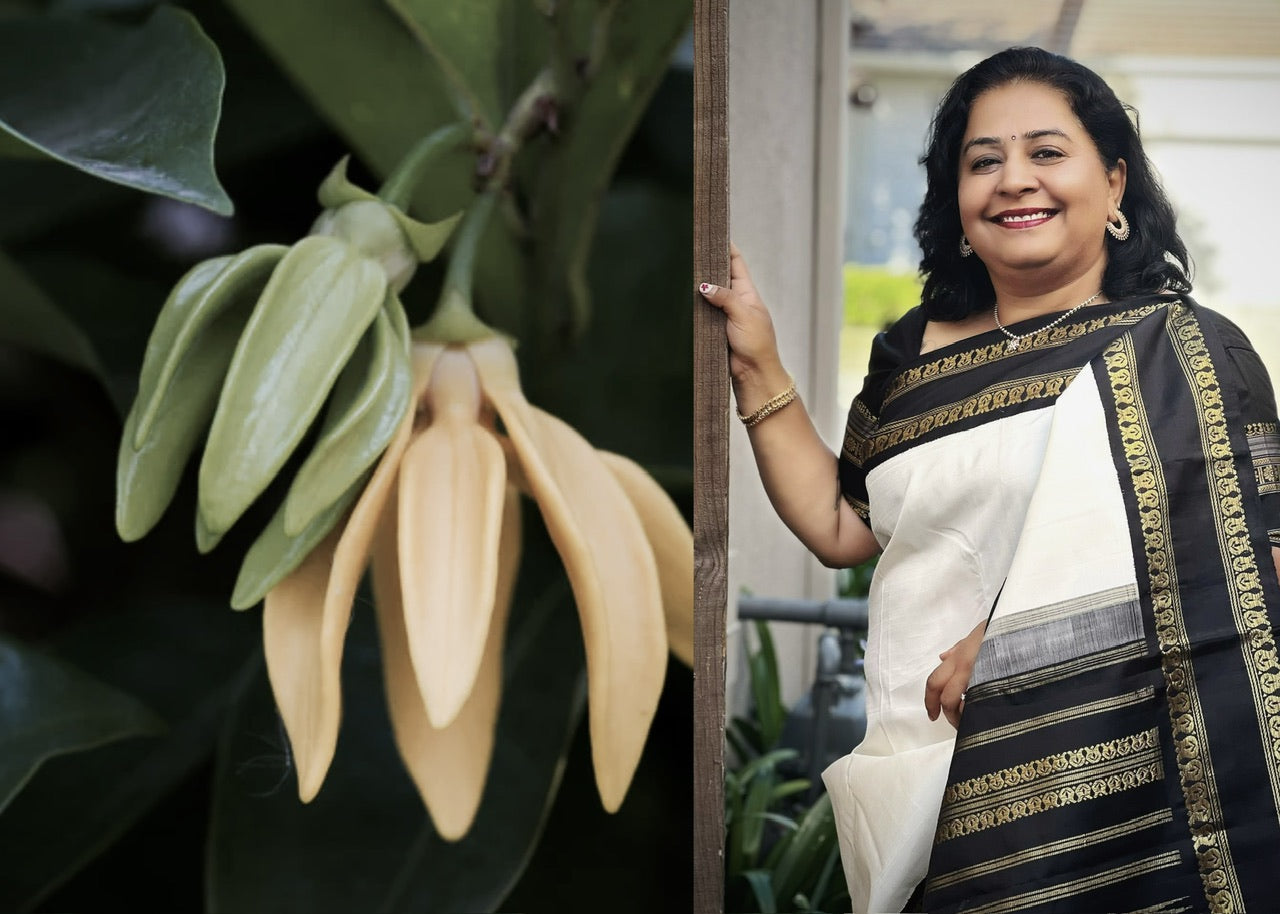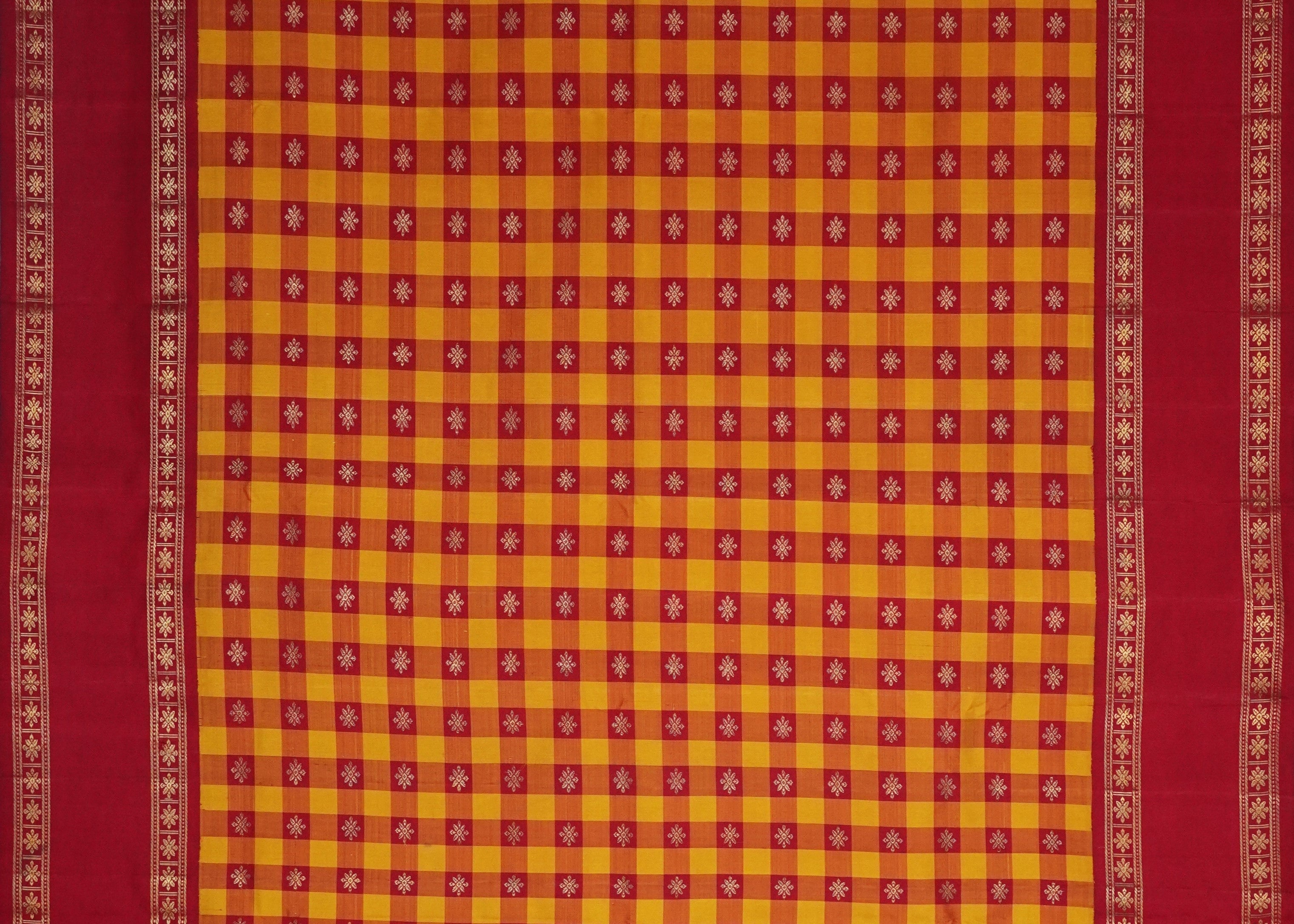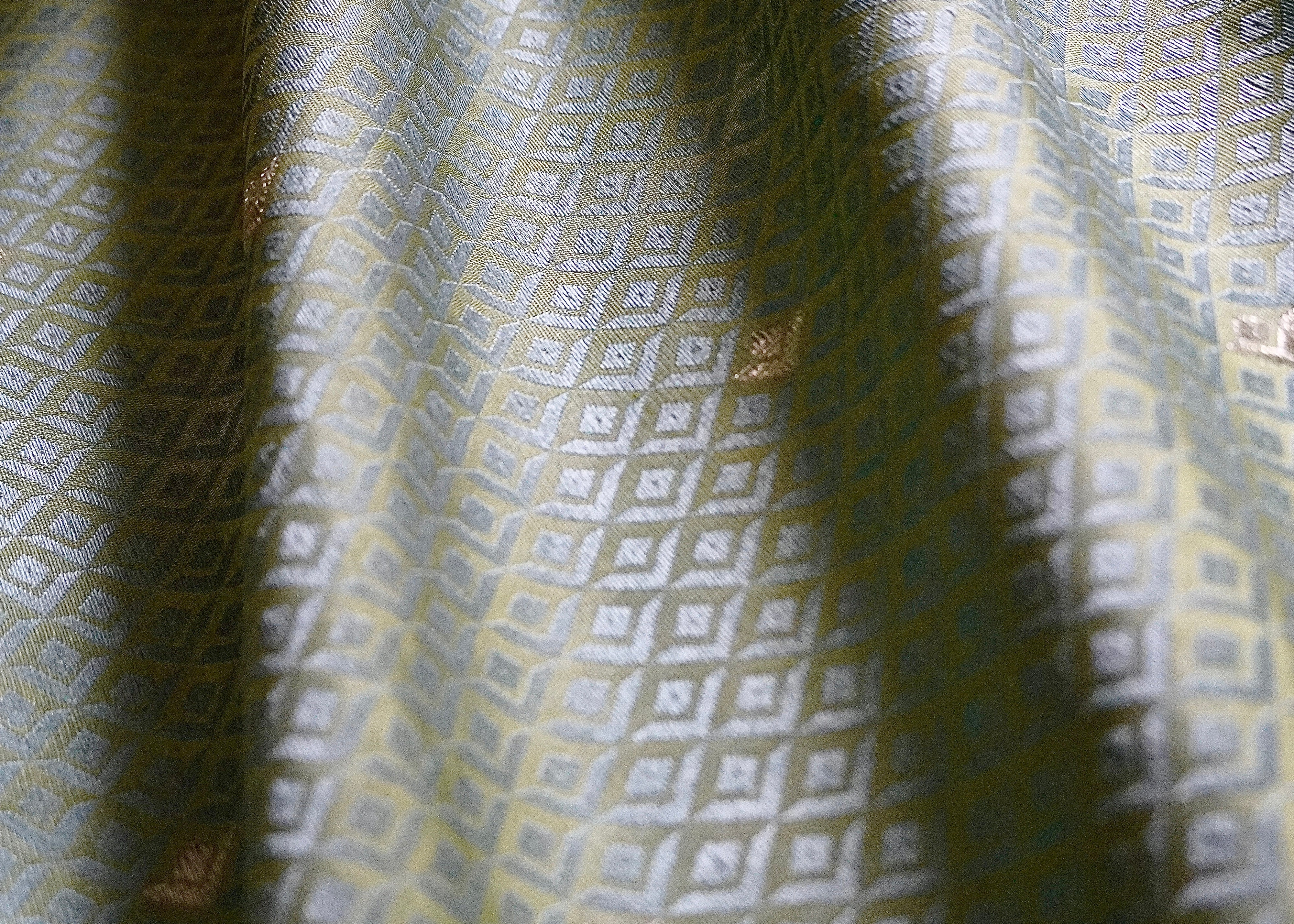
SAMVAAD – IN CONVERSATION WITH VIDHYA RAGHUNATHAN
Getting to know our patrons and exchanging ideas has been a big part of how Parvai works. Our interactions with patrons allow us to understand what they like & enjoy wearing. Since over half of our work is commissioned, we end up working closely with our patrons during the process of design development & production. We enjoy exchanging ideas, knowledge and draw energy from the patronage we receive.
With Samvaad, we hope to share some of these interactions in a series of informal interviews with our patrons. Vidhya Raghunathan is a software engineer by profession who has been living & working in the US for over 15years. Her love affair for saris began early in life and while the preferences may have changed, her love has only grown and evolved. We spoke to Vidhya before her visit to our looms and here is a snapshot of Vidhya’s perspective.
VIDHYA’S RELATIONSHIP WITH SARIS

Parvai: Vidhya, we have all been following your journey on Instagram and would like to know a little more about how your early life shaped your love for sari today.
Vidhya: Like most of us, wearing a sari came naturally to me. I had seen women in my life wear saris all their lives. And when I was introduced to sari wearing, I must admit I did not particularly enjoy it. The saris I wore back then were chiffons and georgettes which seldom stayed in place. But when I began my career, I made an effort to wear saris and would pick cotton saris to wear the work. I think falling in love with saris was a gradual process. As I was discovering my sari preferences, I got married and moved to the US. Sari suddenly became much more than an outfit. It brought a sense of nostalgia in a foreign land. It was the “something familiar” in an unfamiliar landscape. It helped forge friendships, establish identity and instill pride. I started to look for occasions to drape one now. Thanks to the pandemic, we had the time to now document these moments and share them with little snippets.
Parvai: That is so true. While the pandemic was truly a terrifying time for the world, it did allow us to explore our passions and handloom industry saw a lot of innovations happen. At Parvai, we managed to do some of our best work during the pandemic. Tell us about your ideal sari Vidhya. Do you have a type, Vidhya?
Vidhya: Haha, yes. As I said, I don’t really enjoy light weight saris or saris that require a lot of pins to stay put. Over time I have realised I gravitate towards traditional prints, motifs and colour combinations. There is something beautiful about these yesteryear combinations. I just love the timelessness of these saris. Call it nostalgia or my culture, I love traditional sari motifs and colours. As for the texture, I love my saris to have a good fall and weight. So my ideal sari I have realised in a traditional Kanchipuram silk – well woven, in pure silk & zari, with traditional colours and motifs. As I wear saris more, I understand a little more about the weaves and also about myself. I have started to find out a little bit about the process and this helps me understand myself and the weaves better.
Parvai: So, what does handloom mean to you today?
Vidhya: Handloom is a part of our culture. And the weaves are a part of our contribution to the world. Having travelled the world, I know our Indian weaves are distinct and very few countries have anything close to what we do. We also have surprisingly managed to preserve it while many others have lost their culture & heritage to modern machines. I feel handloom is a part of my personal identity. But on the other hand, I realise handloom is a much-abused jargon today. Handloom sells and hence every single sari is sold with handloom, hand-crafted, hand-spun tags and that is the flipside to this.
Parvai: Technology is enabling us to speak from two different locations and yet has brought us together to speak about something that we are passionate about. Speaking of social media & e-commerce, how has technology changed the way we shop? Apart from shopping do these platforms provide a stage for self-expression?
Vidhya: Facebook is full of saree groups and communities. Most of us began our saree journey from these groups. They fostered the interest to wear and share. But overtime, I personally found there was a lot of pressure to wear and flaunt. The group themes would make us shop for sarees we didn’t have and didn’t necessarily need or like. The emphasis is only on wearing and hardly any meaningful discussions about the weavers, the weavers or the process. I also believe it helped build the sense of community & find like-minded friends but I outgrew these groups soon. I found it easy to follow people I like and discuss weaves with people I enjoy chatting with on Instagram & continued documenting my journey there.
Apart from this, social media has made us embrace normal weaves and not fall for what an actor wore in a movie. We have all come so far from merely aping actors and actually appreciating handloom saris. I have learnt a lot from social media about weaves like orissa silks, patolas, ikats, embroidery and block prints from various parts of India.
That said, online shopping has made sarees very accessible to people like you and me who do not live in India anymore. Earlier, saree buying was restricted to India visits or when friends went home and could carry back a small stash. Today, everything is a click away. This has resulted in a wider appetite to wear sarees within my circle. We enjoy shopping and wearing sarees more. That is definitely a boon to many who live in faraway lands.
VIDHYA’S TRYST WITH PARVAI
Parvai: Tell us how you discovered Parvai. Was it through social media too?
Vidhya: Funnily enough, I did discover Parvai from social media. A person I follow, Karthika, had posted about her grandmother’s sari being recreated. The sari was called Meenambal and was available for purchase. My journey with Parvai began with Meenambal. Although I had been following Parvai and AHC handles on Instagram I never understood what they stood for. Today I know and understand how Parvai works. I have had the privilege of knowing and interacting with Effie Thomas, the founder of Parvai and have learnt so much from my interactions with her.
So yeah, social media is such a boon to so many of us who wish to access information that has long evaded us. What a magical time we live in!

Parvai: Absolutely. I guess you definitely have an enviable collection of sarees now. What does your family think about your love for handloom and sarees?
Vidhya: Haha, that is a very interesting question. My family has always known I love saris. But today they appreciate that I am passionate about handloom saris. They realise my love for sari is beyond just vanity and flaunting. They understand how much I research and read up about saris. They believe I am on my own path here. And there is a lot of respect for it. I find my friends and relatives now reaching out to me for recommendations. Many of them still do not understand weaves or can’t tell a powerloom from handloom. They reach out to me for help and information. It feels nice to help them discover a bit more about handlooms and I completely cherish these interactions I have.
My sari journey has given me something to talk about beyond work, family and kids. When I am out with friends or at celebrations, the topic invariably goes to saris and handlooms and I enjoy these little conversations.
Parvai: Do you believe online selling is changing the way we buy and wear sarees? And the tougher question is does all the selling that is done impact the handloom industry in a positive way?
There is no doubt how we wear and enjoy saris has changed. Online sellers have brought the saris to our mobile phones and made it easy to shop. I, for one, have benefitted hugely from this. Does online buying come close to physically trying and buying – well no. But I believe if we can establish a level of trust with a seller/shop then the process becomes easier. I would definitely ask people to approach with caution, ask a lot of questions and even see the sari on a video call before buying.
Today, after buying a lot online, I feel ready to hold back and buy in person. This India trip, I have enjoyed the old school process of visiting stores, touching saris, deciding on a purchase based on so many factors apart from what looks nice on photos.
We have all been told that handloom industry is dying and that our purchases help weavers. This might have been true during the pandemic but I highly doubt of its true today. We only hear of the poor artisan before making the purchase and seldom after. So, it remains to be seen if all thus hype translates to anything meaningful for the artisan community.
Parvai: Tomorrow you are leaving to Kanchipuram on a trail. How do you feel about it? Tell us what is that you are looking forward to?
Vidhya: Oh, I am very excited. I am going with an open mind but I also feel like a kid in a candy store. I have heard so much about the process, read books, articles, seen videos and spoken to people but never actually stepped foot in a loom. Tomorrow I am hoping to clarify doubts, learn about the process, see a power loom, assisted loom and handloom, talk to weavers, understand the techniques better and overall gain a better perspective of handloom.
Parvai: What do you feel about weavers and their lives before you go and meet them? Do you feel you are adding value to their lives?
I have been told they have a tough time. In fact, I believe most of them have abandoned the craft and moved on. There are constant updates by sari sellers about how the craft is dying. But one never sees that. We hear about their tough lives and buy saris. But how does our buying help them – this part remains a black box. I don’t even know if our collective purchases help sustain craft or merely help the businesses prosper. So, this is something that has been worrying me lately and I want to uncover this tomorrow
We spoke to Vidhya before her visit to Kanchipuram & caught up with her after. Vidhya visited Parvai’s looms as well as other looms in the temple town. Vidhya describes this visit as a life-changing experience and we were happy to hear her thoughts about it.
VIDHYA’S VISION FOR HER FUTURE SELF
Parvai: Vidhya, how are you doing? How was the visit to Kanchipuram?
Vidhya: Oh.. I am still grappling with what I saw & experienced. It has been an overwhelming journey for me and I am still digesting everything I saw, touched, spoke and heard. There is only so much the internet and social media can teach you. Nothing comes close to actually visiting and learning.
Parvai: So, was the experience close to what you thought it would be?
Vidhya: In some respect, yes. I have watched videos of looms, seen saris being woven on YouTube, heard people speak about the weft, warp, punch cards, adai, jacquard and all the terminologies. But to actually see it in person… boy, nothing prepared me for that. Simply put, all these years of social media, internet and online education contributed to less than 20% of what I know now. I learnt so much in one day thanks to Parvai and Nikhil. Nikhil took us around, showed us powerlooms, assisted looms, explained the processes, showed us every little detail that goes into making a sari. From the little bells to the punch cards, every single aspect was explained and I felt like I was Alice in her wonderland. I would highly recommend any sari lover to visit looms and get educated. Ask questions, interact with the weavers and understand the whole process better.

Parvai: Haha, did you also buy some of the saris?
Vidhya: Yes, I did. I bought a sari from the loom. The sari is still being woven and she is called Devanshi. I was lucky enough to sit and spend time with weaver who was weaving the sari. Thanks to the heavy body brocade technique, the sari takes 45-60days to weave. Both me and my husband tried our hands at weaving and we wanted to purchase the sari to remember the say. Having contributed in a miniscule way to the weaving, we wanted it to be a part of our family heirloom. So, this purchase was not motivated by trends or jargons, but merely something for me to remember this trip by. My husband also gifted me a sari from Parvai looms for our anniversary.
Parvai: Looking forward to seeing you drape them and post about them on social media. But tell us how shopping was different this time around?
Vidhya: Yes, so this was a very different kind of experience to me. Nobody sold me any sari. I requested to buy the saris out of love. The weavers have been glorified as some demi-gods and the master-weaver as some kind of Picasso. But reality is they are normal people like you and me, suffering from basic human flaws, trapped in a society that doesn’t value them as much as they should. But despite all that, the weavers patiently answered our questions. They never asked us to buy a sari.
One thing I must mention though is that the Parvai looms were way different from the others. They were well ventilated, cleaner and the weavers seemed happier to have a clean and airy work space. I am told, some looms have inhuman working conditions. I pray & hope that changes.
Anyway, I really can’t call this shopping. Shopping was a byproduct of the visit. My purchases were investments to my knowledge and my passion. This time around, everything was different. There were no sugar-coated words, marketing gimmics, jargons like revival & rare weaves thrown in. There was absolutely no pressure to buy anything – in fact, nobody was selling anything to me. Haha. Such a refreshing change to spend time learning about something that is close to my heart.
Parvai: Couldn’t agree more about weavers and looms. They have been glorified and sometimes portrayed as something they are not.
Vidhya: Indeed, they are just people like you and me.
Parvai: What was the high and low point of your visit?
Vidhya: There were so many “aha” moments. But I should mention, as I was coming back, I was thinking about the looms and the conditions in which a sari worth several thousand or even lacs is woven. In the showrooms, they are exhibited with much pomp and splendour when they are woven with the most basic of instruments. Old liquor bottles are used as weights, a broken kodam (pot) becomes a winding station for bobbins and there is absolutely nothing sophisticated about handloom – and therein lies its beauty too. And yet, it is presented as though the artisan sat in a perfect studio and wove them. The sweat, grime and hard labour is seldom shown in showrooms. I wish they are able to share these details in showrooms. That would help engage the modern sari buyer better.
Personally, I was also thinking about how I have visited Kanchipuram so many times and was feeling ashamed about the fact that I was not curious enough to walk into one of the looms. I now recall even seeing the saris being warped and sized by the roads and yet, while I went to the showrooms and stores, I seldom asked to see the looms.
Of course, it is never too late to learn and I am so happy this happened. I walk back wiser and humbled by what I have learnt. My heartfelt thanks to Parvai and Mr Nikhil from your team for making this happen on such short notice.
Parvai: Definitely these visits open our minds and experience is the best teacher, after all. You spoke about getting wiser. Can you elaborate?
Vidhya: Of course. We have a certain image of the weavers & artisans. They are portrayed as being pristine & pure, blameless & faultless. When of course, the industry is like any other. I came to realise from my interactions that the job is not easy but so is the attitude of many weavers and helpers in the industry. While they absolutely deserve our help, it needs to be channelled well. Merely buying saris is not going to help anyone.
Parvai: Does this mean, you will change what & how you buy?
Vidhya: Most certainly. I know for a fact that I will not be buying from sellers on Instagram & Facebook anymore. I am also done falling for terms like “master weave”, “rare weave”, revivals” & “vintage”. I feel such purchases do not help the community eventually. I want my purchases to be purposeful and hold some meaning.
While I have benefitted from online sellers during the pandemic, this trip made me realise how much I miss the process of trying & buying. Whenever possible, I would like to visit looms or weavers and buy directly from them. I also know there are many organisations like Parvai who work for the upliftment of the community and I would like to buy through them. I am done with meaningless, indiscriminate purchases and want to wait, think, research and only buy if I am completely satisfied.
Parvai: Do you feel a sense of responsibility now?
Vidhya: I do. I feel very responsible for everything I write. And I feel like I can’t just write anything that I am told. If indeed a weaver is going to benefit from a program, I urge sellers to share the impact they created from the sales. Share how the community has benefitted. From being someone who bought saris on a whim, I wish to become a person who buys with intent. I don’t feel I should chase likes & followers but share what I feel is right with people. I want my content & my sartorial investments to mean something. The time is right and I have to act now.

There are a lot of thoughts in my brain right now with respect to what and how I buy and what I share. I am sure these little seeds that have been sown will germinate and allow me to find my space of self-expression. I realise now that this is a path that I have chosen for myself. I am not ashamed to admit I have made some mistakes but I hope they have taught me something. It remains to be seen where it all leads but we will find out soon enough!
Parvai: This whole chat has been beautiful. It feels so right to hear what you have to say. I can see how impactful your visit to looms have been. It certainly looks like you are on a journey and so glad we could exchange ideas & thoughts today.
When we lament about the handloom industry and the life of weavers and all the things that are wrong today for craft, we blame the government, the middle men, the sellers and everyone involved in the cycle of craft. But we forget to include us, the buyers or the patrons of craft. This whole buying & selling is a two way street, so don’t you feel we have a role to play as buyers too?
Vidhya: Of course. This is my personal take away too. Sellers who claim they are reviving saris & experts, must be more proactive to show us how exactly these revivals impact the industry. If not the industry at least a few weavers that they work with. Do they get a salary that is on-par with industry standards? Do they get other benefits like bonuses and incentives? How humane are the working conditions? What are we doing to improve their lives? All of this must be shared. Else all these revivals & master weaves are pointless.
As buyers, it is time to be more informed, as more questions, visit looms, talk to the artist community, do some research and hold sellers accountable for their marketing statements. There is a lot that depends on us the buyers and to be honest we are as much to blame here.
Parvai: We understand you had a lot of questions about zari & even got a few saris tested. What role does zari purity play in a buyer’s purchase process
Vidhya: I have been sold a number of saris as “pure zari” and I wanted to get them tested this trip. The process of testing zari purity is simple and results are obtained in a couple of hours. What I realise is, pure zari may not be a pre-requisite and even 3g zari saris can look elegant. But what I would appreciate as a buyer is sellers being upfront about this information. A huge part of what we pay for a sari goes to zari and as buyers we have the right to know what goes into the making of our saris.
Epilogue

Parvai has long maintained that patronage has a big role to play in shaping the craft industry. Having worked with the craft community not just for our projects but also community outreach projects, we realise how important the buyers are in deciding what gets made. From the base materials to the process, the wages to the value of the product, everything eventually rides on patronage & appreciation for the right craft. We have seen trends and inflated demands do more damage to the craft than help. And we are so glad to be able to find our tribe of women who resonate our values, understand our perspective and work with us to make whatever little impact that we can create.
Vidhya’s questions about zari and purity helped us re-define our offerings. At Parvai we have always been upfront about the kind of zari we use in our saris. We have used 5g, 3g & 2g zari in projects and shared the same openly on our website & with out patrons. Vidhya’s conversation led to some introspection and we have henceforth decided to call only 5g zari saris as pure zari range.
High quality zari is a worthwhile investment in the event a patron decides to resell the sari. When a sari involves considerable technique & man hours involved, it makes sense to invest in high quality zari since the sari may be deemed a collectible. However, for regular usage, there is no reason someone should not choose a zari of lesser purity. This is a patron’s choice to make and Parvai would like to enable this for them.
What started off as a harmless conversation transformed into a powerful moment that will define how Parvai views zari purity going forward. Patrons & their patronage continue to transform how this industry operates.




1 comment
Love love this interview thanks for giving me time and space to share my thoughts
Thanks Parvai for acknowledging my zari question and acting upon it !! Best wishes to the team for all projects
Vidhya
Leave a comment
This site is protected by hCaptcha and the hCaptcha Privacy Policy and Terms of Service apply.